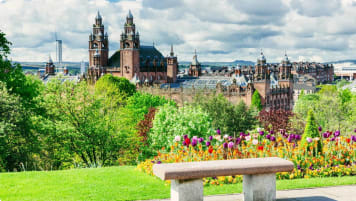Continental Crossroads: Discover Morocco
Morrocco, ancient civilisation, blue city, white city, Berbers, The Romans, Portugese the history rolls on for this country in North Africa. Join a small group vacation package that tours Morocco. A tour of Morocco for mature and senior travellers, couples or singles over the course of the itinerary, the history, culture and landscape are all explored, from Fez to Marrakech or the Cave of Hercules.
20 Apr 20 · 11 mins read

Continental Crossroads: Discover Morocco
Morocco is a land of incredible diversity. On an Odyssey Traveller Morocco tour of this magnificent country you will encounter bustling marketplaces, grand and ornate architecture, spectacular deserts, rugged mountain ranges and thrumming African cities. Situated at the crossroads of two continents, this corner of North Africa been repeatedly conquered and reconquered over the centuries, first by Romans, later by Arabs and sporadically by its indigenous Berber tribes. This turbulent history is reflected in its amazingly diverse landscapes, architecture and culture. Odyssey has multiple tours of Morocco scheduled each year for small group package tours to this fabulous destination.
A cultural crossroads
Morocco has a deep human history. This important sliver of inhabitable land between the Atlantic ocean and the northern Sahara desert has been occupied by homo sapiens since palaeolithic times. A recent discovery of human fossils dates back nearly 315,000 years. Another recent study has found links between the DNA of Moroccan peoples and the indigenous Saami of Scandinavia in Northern Europe, suggesting a shared ancestry predating the last Ice Age. During these times, North Africa was fertile savannah, very different from today’s much more arid landscape.
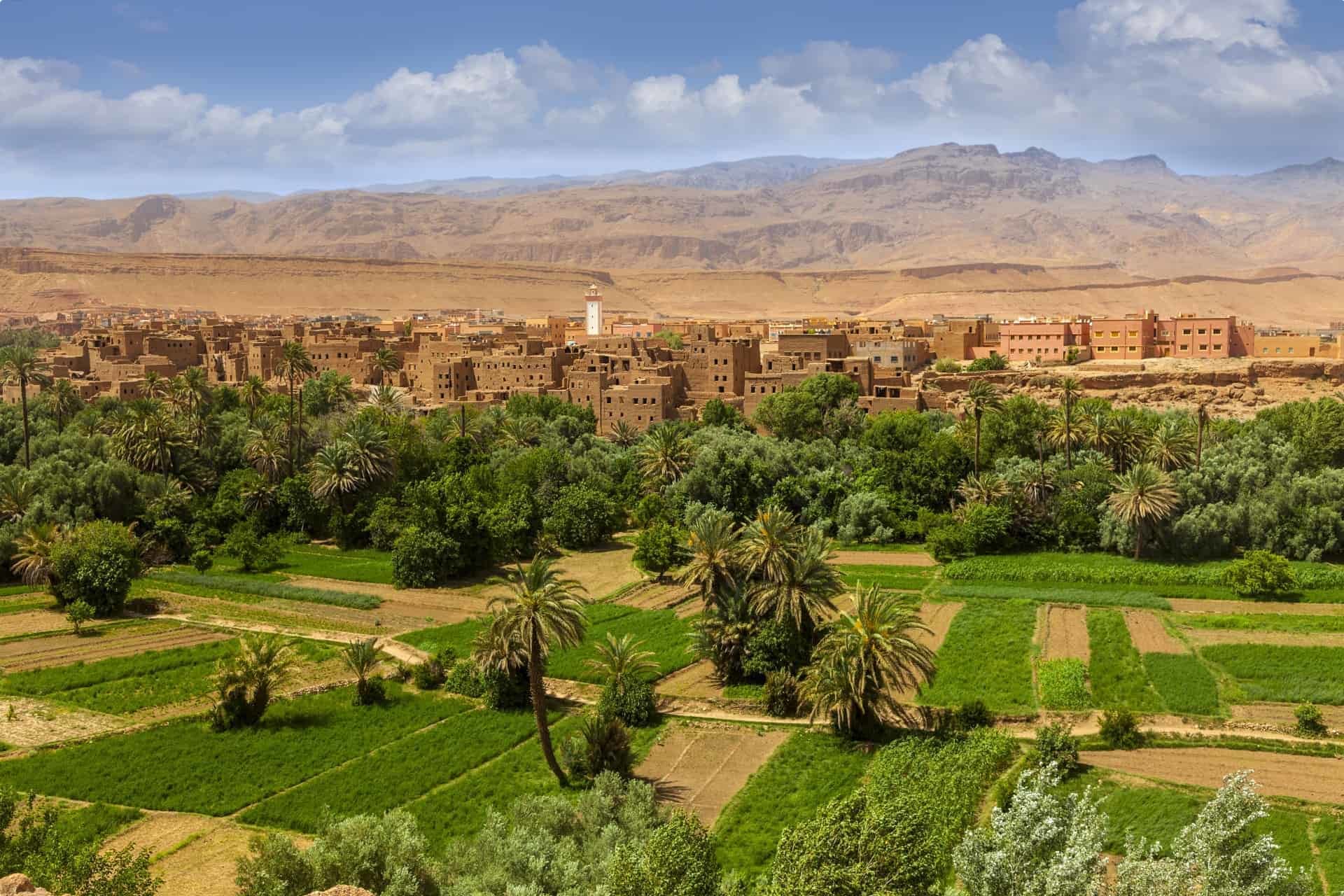
Berbers
The descendants of the indigenous peoples are known as Berbers. The origins of the name Berber are contested: some believe it is derived from an ancient Egyptian term meaning ‘outlander’, while others argue it is a Roman word meaning ‘barbarian’. Many Berber peoples call themselves ‘I-Mazigh-en’, meaning ‘free people’ or ‘noble men’.
The vast majority of North Africa’s population is believed to be of Berber origin. Today there are a large variety of Berber societies and ancestries. These groups are usually unified by a shared language or history. There are between 25-30 million Berber speakers in North Africa, but there are many more who have acquired new languages over the centuries. Some of the best known ancient Berbers are the Numidian king Masinissa, the Berber-Roman author Apuleius and the Christian philosopher Saint Augustine of Hippo.
Phoenicians
Though humans lived there for millennia, it was not until the arrival of the Phoenicians that Morocco came into contact with the wider Mediterranean world. Phoenicia was an ancient civilisation originating in the Eastern Mediterranean near modern day Iraq and Syria. The Phoenicians set up cities and trade routes along the North African coast, eventually conquering most of the coastal regions of Morocco between 1200 and 800 BC. From their capital in Carthage in modern day Tunisia, the Phoenicians dominated coastal Morocco, while the mountainous hinterland was ruled by indigenous Berber monarchs.
Romans
The Romans arrived in the 4th century BC and named the area ‘Mauretania’. During this period, the Berbers ruled most of Morocco independently, overshadowing the Roman coastal settlements. Roman military power counted for nought in the rugged mountainous territory. Instead, they managed to maintain control through alliances with the Berber tribes.
In the 3rd century BC, the Romans and Berbers built the ancient city of Volubilis, near modern day Meknes. This is a must see destination for travellers to Morocco. Built on fertile lands on the slopes beneath the Zerhoun mountain, the city grew substantially throughout the 1st century AD. At its peak, Volubilis had around 20,000 inhabitants. For a provincial Roman town, this was quite large. The city boasted grand public buildings, including a basilica and a triumphal arch, mined from local limestone.
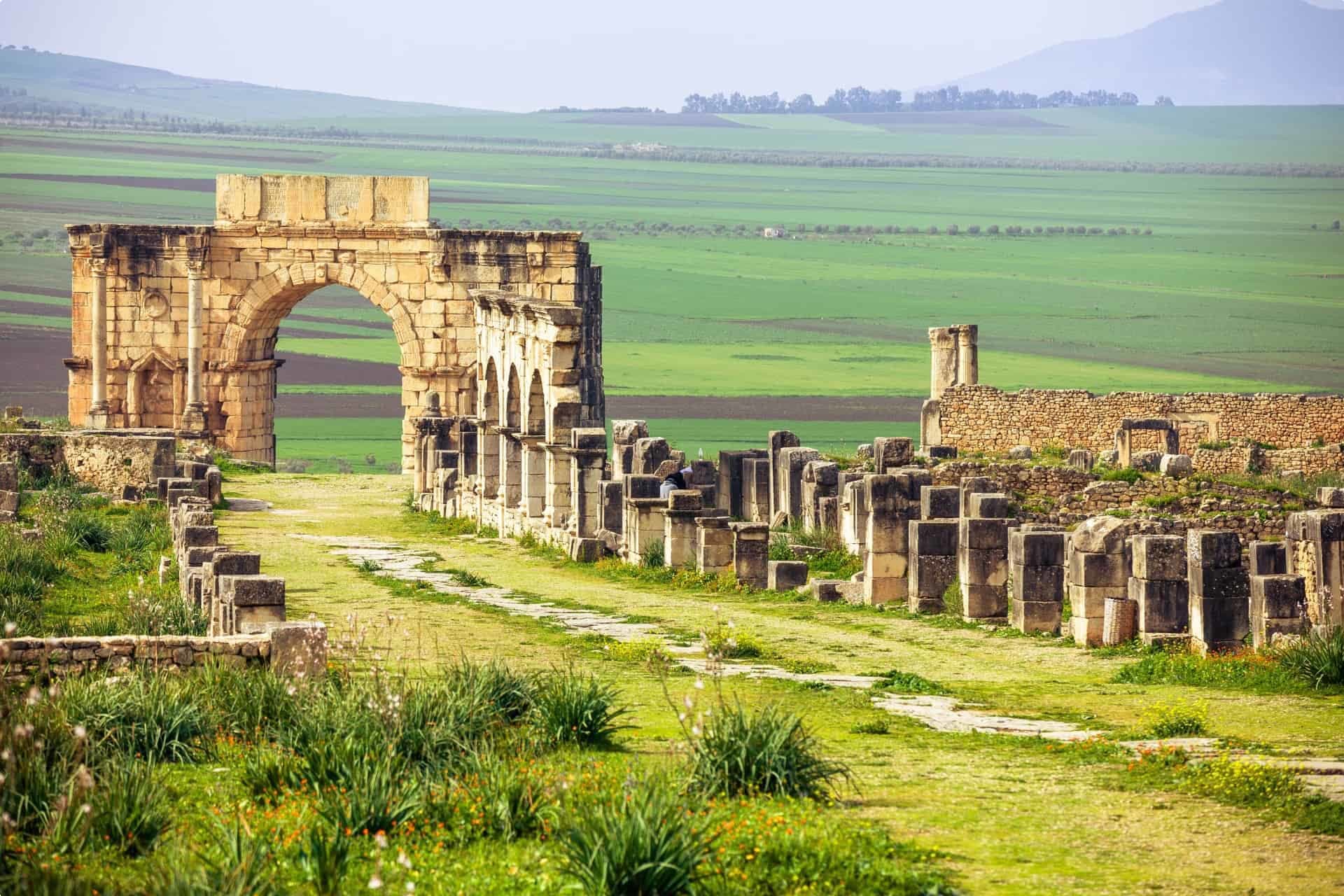
As Rome slipped into decline, the Berbers continually harassed their foreign rulers from their base in the Atlas Mountains, ultimately forcing them out. In 285 AD, Volubilis fell to local tribes and was never retaken by Rome, deemed too remote by distant Roman rulers. Berber agitation was a threat that would haunt many a Moroccan ruler over the centuries.
Muslim Conquest
In the 7th century AD, the Prophet Mohammed’s armies set off from the Arabian Peninsula and expanded Islamic influence across North Africa. Nearly all Berber tribes embraced their own unique from of Islam. This commenced a cycle of rising and falling Islamic dynasties that dominated Morocco from the 9th century AD to the present.
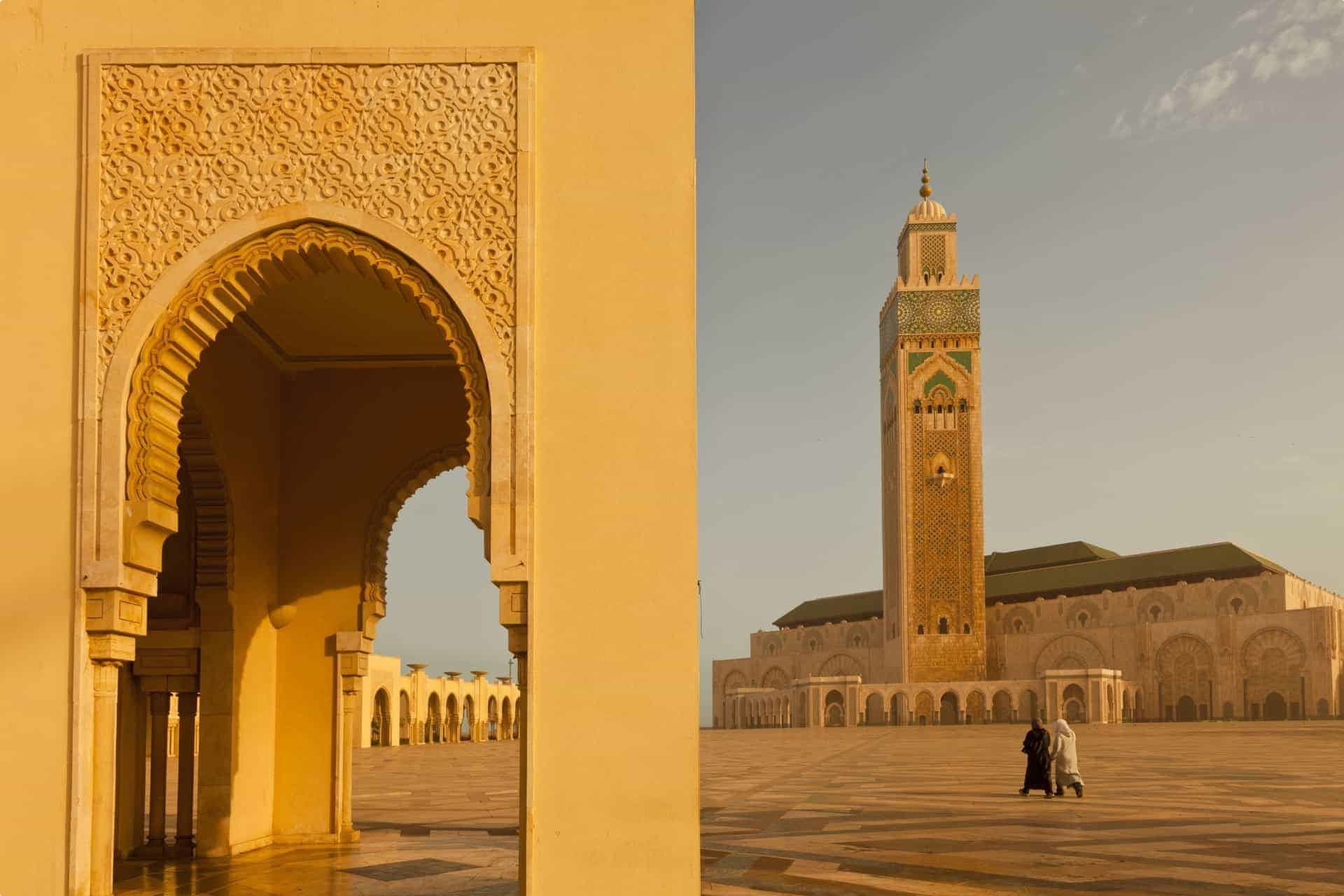
Major dynasties of Islamic Morocco
- Idrisids (829-1062) – Named after the founder Idriss I, the Idrisids are thought by some historians to be the founders of the first Moroccan state. During this time Islamic and Arabic culture gained a stronghold in Moroccan towns, mainly as a result of trans-Saharan trade, which was dominated by Muslim Berber traders. However, Arabic influence was limited to the towns, with most people still using Berber languages.
- Almoravids (1062-1147) – The Almoravids were the first of the powerful series of Berber dynasties that dominated Morocco for nearly 500 years. These tribes originally rose to power south of the Atlas Mountains and expanded their influence northward. The Almoravids fought a number of battles against the Christian kingdoms that helped maintain Islamic control of modern day Spain and Portugal.
- Almohads (1147-1269) – Known as the Almohad Caliphate, this was a Berber Muslim movement founded among the Masmuda tribes of southern Morocco. After overthrowing the Almoravids by conquering Marrakech in 1147, they extended their power all over Northwest Africa and the Iberian peninsula.
- Marinids (1269-1465) – The Marinids were Sunni Muslim Berbers who were known as patrons of culture, developing their capital, Fez, into a center of Islamic learning (in schools knows as ‘madrassas’) and architecture. Their rule was also characterised by religious toleration: Jews and Christians even fought in Marinid armies. Many of the madrassas they built are still functioning today.
- Saadians (1524-1659) – The Saadians were the first of a series of Arab dynasties who claimed descent from the prophet Muhummad. Their name derives from “sa’ada”, meaning happiness or salvation. The most famous Saadi sultan was Ahmad-al-Mansur, who built the El Badi palace in Marrakech with Portuguese ransom money to commemorate victory in the Battle of the Three Kings. The palace – these days a well-preserved ruin – is an absolutely essential stop for any traveller to Morocco.
- Alaouites (1659-present) – The Alaouite dynasty is the current Moroccan royal family. Ismail Ibn Sharif consolidated the Moroccan kingdom and created a unified state, despite opposition from Berber tribes. Without their support, Ismail was forced to control Morocco with an army of slaves, which he used to drive the English from Tangiers and the Spanish from Larache. Later sultans further consolidated the kingdom, setting up trade links with Europe and achieving control over Berber tribes.
Incredible Islamic sites
With over a thousand years of Islamic influence in the region, Morocco is home to some of the most amazing architectural sites in the Mediterranean world. Morocco’s buildings reflect the country’s diverse cultural and historical makeup: from the mudbrick fortresses of Berbers desert clans to the arches and tiling of Moorish Spain, and everything in between.
Ben Youssef Medersa
Be sure not to miss one of Morocco’s oldest and most splendid Quranic learning centers. Built in Marrakech by the Marinids in the 14th century, it was once the largest madrasa in all of North Africa. This magnificent structure features mosaic tiled walls, hand sculpted plasterwork and ornate woodwork. As you enter, the inscription over the archway reads: “You who enter my door, may your highest hopes be exceeded”.
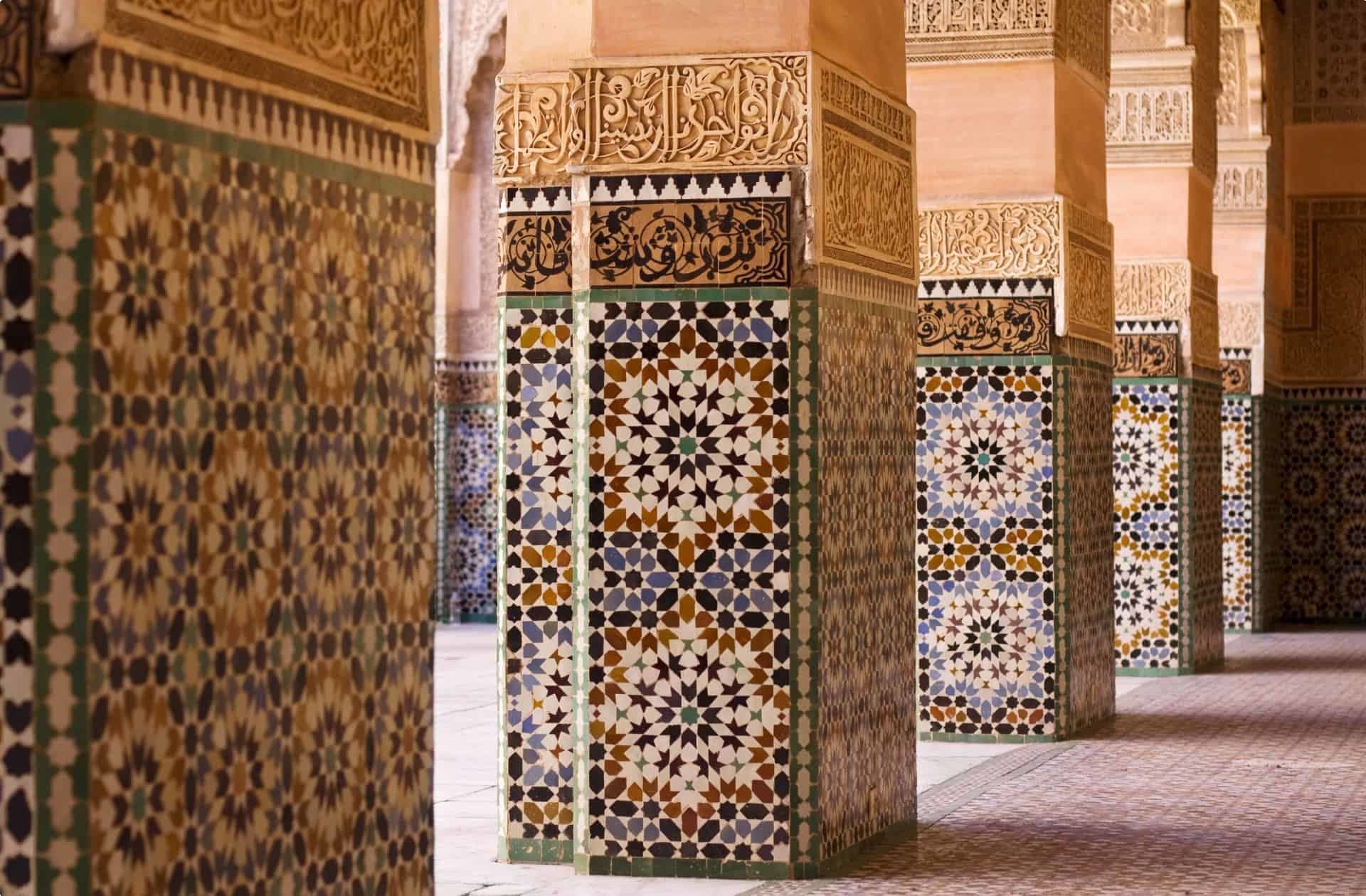
Saadian tombs
This stunning marble and gold mausoleum chamber was constructed by the Saadian Sultan Ahmed al Mansour to house his tomb. Located just south of the famous Kasbah Mosque, the tombs comprise the interments of sixty members of the Saadi dynasty. The mausoleum is composed of three rooms, the most famous of which is the Hall of Twelve Columns. Amazingly, the tombs were only discovered in 1917, and have been a major attraction ever since.

Qarawiyyin
At the heart of the beautiful mountain city of Fez sits Qarawiyyin, a huge working mosque that services an almost constant stream of worshippers. Its unmistakable green roof can be seen from the picturesque hills surrounding the city. Qarawiyyin is one of the world’s oldest universities and has historically been a major intellectual center of the Islamic Mediterranean. While you’re here, be sure to wander over to the Chaouwara Tanneries, where craftsman demonstrate a leather dying process that dates back over 500 years.
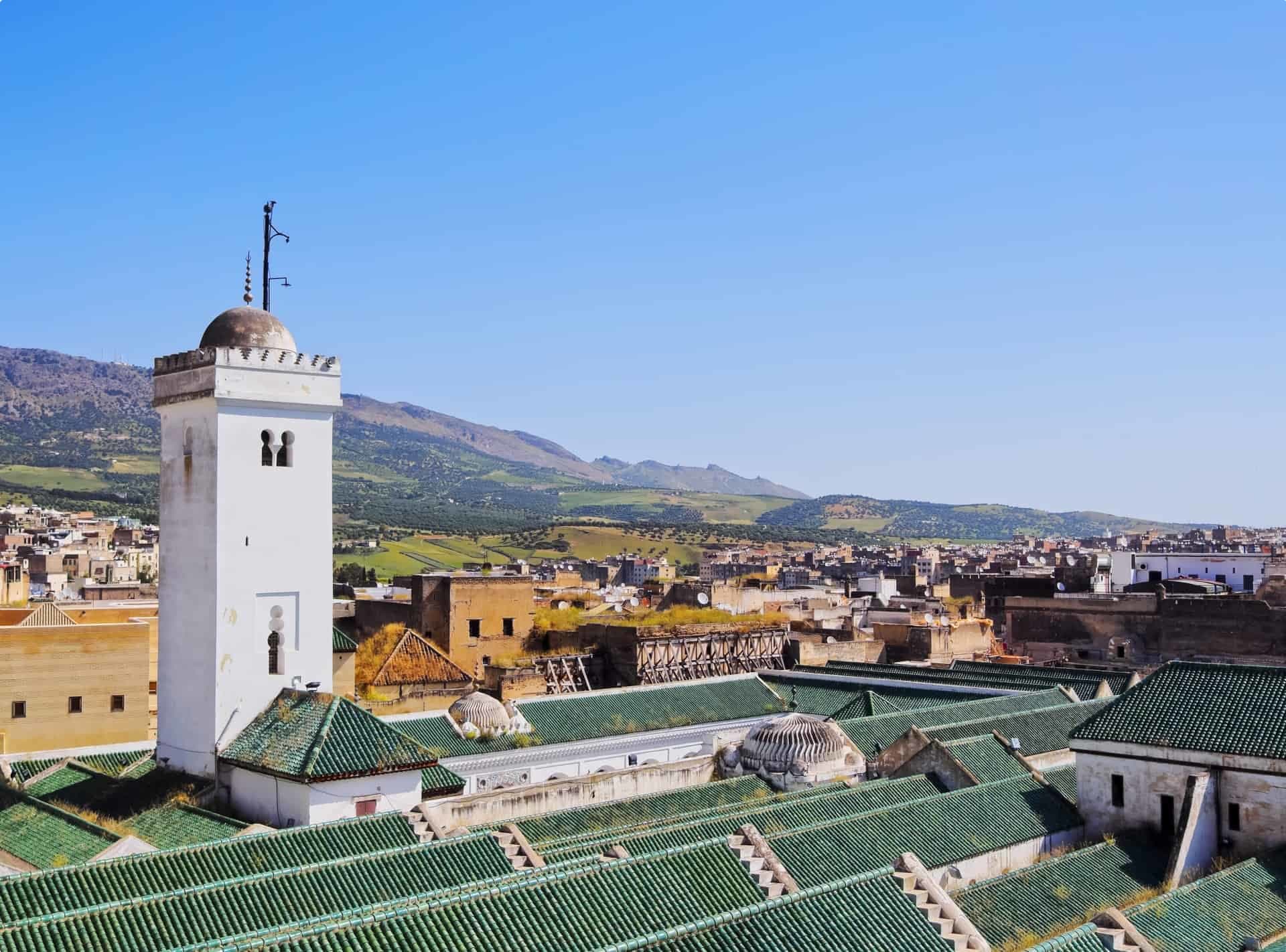
Hassan II Mosque
Known colloquially as the ‘Casablanca Hajj’, the Hassan II Mosque is the largest in Morocco and thought to be the third largest in the world after those in Mecca and Medina. It features the tallest minaret in the world, at 210m, and can accommodate 25,000 worshippers. In contrast to many of the other famous mosques in Morocco, the Hassan II was constructed relatively recently, in 1993. To see the interior, visitors need to be ‘decently and respectfully dressed’, though women are not required to wear a headscarf.
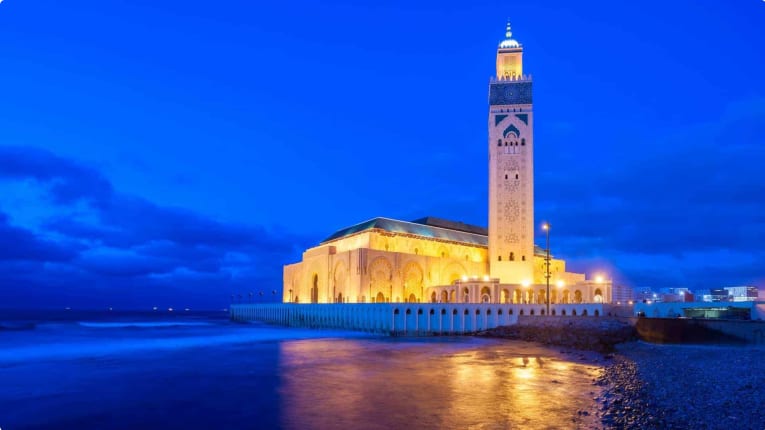
Royal Palace
The Alaouite sultans have long maintained a palace in Rabat, which has since become the capital of modern day Morocco. The palace, known as Dar al-Makhzen, is the current official residence of King Mohammed VI. The building is surrounded by French-style landscape gardens, flowerbeds, antique canons and a central fountain.
Hassan tower
This ancient minaret of an unfinished mosque in Rabat is another essential stop on any tour of Morocco. Begun in 1195, the tower was intended to be the tallest minaret in the world, but when the Sultan died, construction ground to a halt. The tower is ascended by ramps instead of stairs, which would have allowed the muezzin to ride a horse to the top to issue the call the prayer.
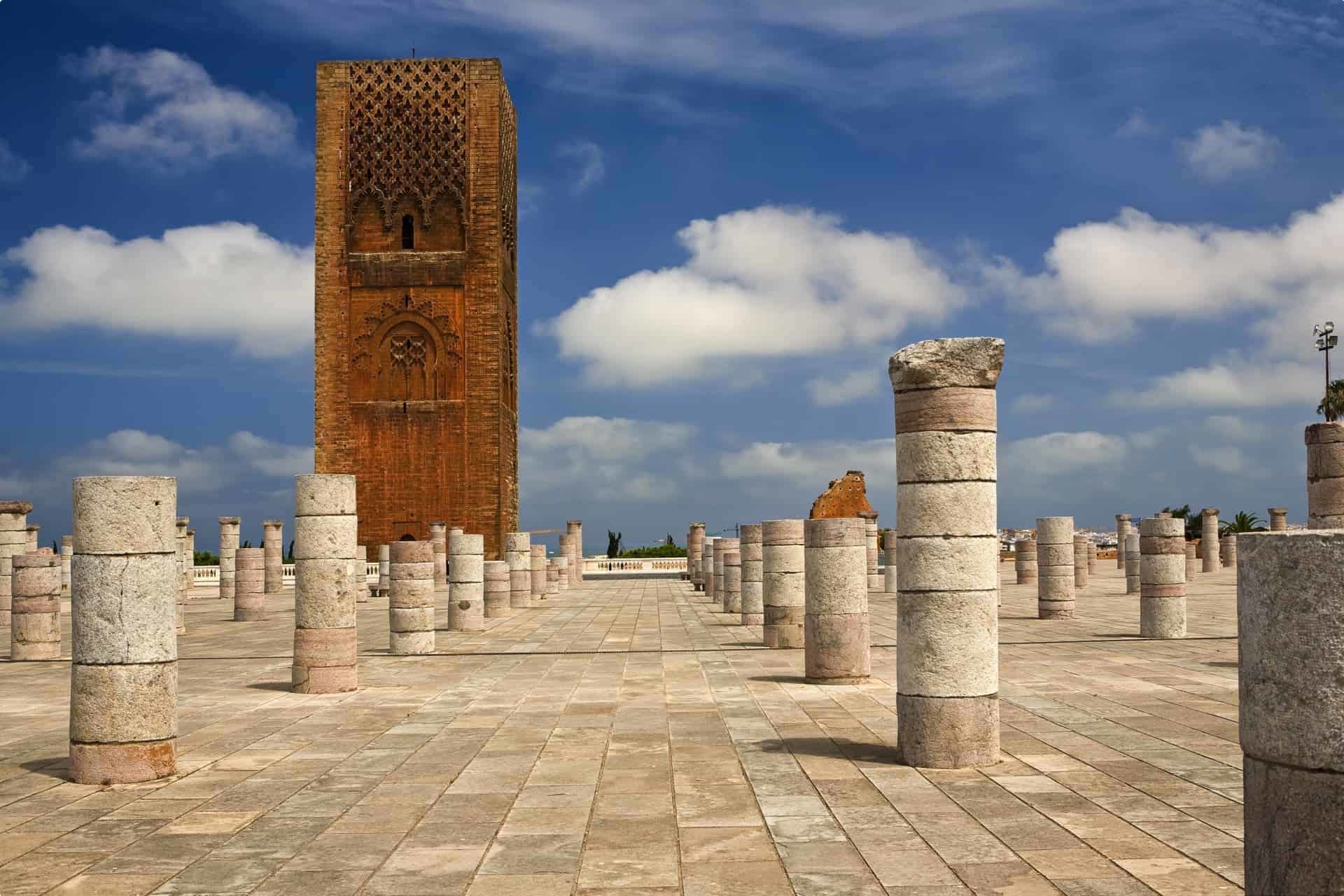
Colourful cities
Marrakesh
Marrakesh is an absolutely essential stop on any trip to Morocco. This enchanting city is a feast for the senses. From Marrakesh’s many rooftop terraces you can glimpse the magnificent Atlas Mountains and the spectacular Koutoubia Mosque. Its famous medina is a dazzlingly colourful maze of alleyways and shops. The labyrinthine streets are living monument to over a thousand years of urban history on the western edge of the Islamic world. Load up on delicious Moroccan foods, sample exotic African spices, marvel at the incredible silks and pottery and listen to hypnotic North African music. Traditional arab markets, called souks, are organised into different commodities: spices, silks, antiques, musical instruments, olives.
Marrakesh is the most important former imperial city of Morocco. Inhabited by Berbers since Neolithic times, the city itself was founded in 1062 by the Almoravid king Yusuf ibn Tashfin. The city’s famous red walls were built in 1122 using red sandstone, and Marrakesh is sometimes called the ‘Red City’ or the ‘Ochre City’. After a period of decline, it was reestablished as the capital of the kingdom by the wealthy Saadian sultans, who embellished it with beautiful buildings like the El Badi Palace. The city also became popular with Sufi pilgrims in the 17th century, who travelled to see Morocco’s seven patron saints.

Casablanca
Most Westerners know Casablanca as the setting for the legendary Hollywood romantic film of the same name starring Humphrey Bogart and Ingrid Bergman. In reality, it is the place to go to if you want to feel like a local rather than a tourist. As Morocco’s most populous city, its charms are often hidden, and it pays to spend some quality time mixing with the locals. Architecturally, Casablanca ticks nearly every box: Islamic, Gothic, Art Deco, modern. Many of the city’s historic villas have been converted into art galleries and museums. Cinephiles will want to check out Rick’s Cafe, the real life version of the club made famous by Casablanca.
Before the modern city existed, Casablanca was once used as a base for pirates trying to raid Christian ships. The Portuguese eventually destroyed the base in 1468, before returning a few decades later to build a town they called Casa Branca, meaning ‘White House’. They abandoned it a few centuries later, but an Alawi sultan rebuilt the town in the late 18th century, and French colonists later turned it into Morocco’s main port city. It grew rapidly in the 20th century and is now the commercial capital of Morocco.
Fez
For over 1000 years, the inland city of Fez has been the spiritual heartland of Islamic Morocco. It is situated at the crossroads of all the important cities of the region. The old city, known as the medina or ‘Fez al-Bali’, is a web of narrow streets and alleys, mosques, madrasas and tanneries. As you wander through this maze of culture, the smell of incense, coffee and spices fills the air. Street sellers peddle their immaculate wood carvings from narrow carts and souks.

Rabat
Morocco’s charming capital is far less touristy than some of the country’s bigger cities. Founded by Almohads in the 12th century as a fortified monastery from which to wage their holy war in Spain, it later became the home of many displaced Andalusian Moors who had been driven out of Spain. The old town hugs the coast, surrounded by its ancient fortifications. When the Almohads fell into decline, losing their Iberian and African territories, the city’s economic power shifted to Fez.
Rabat and the neighbouring town of Sale united in the 1627 to form the short-lived Republic of Bou Regreg, a city state run by Barbary pirates. The pirates, also known as corsairs, attacked Christian ships in order to capture slaves for the Ottoman slave trade. As such, the Atlantic coastline of Morocco is often referred to as the Barbary Coast. Various attempts by the Alaouite sultans to control the pirates failed, and the Republic did not fall until 1818.
Tangier
Tangier lies on the southern side of the Straits of Gibraltar and acts as Europe’s gateway to Africa. It’s proximity to Europe has created cultural and architectural tradition unique from the rest of the country. The city’s formerly seedy reputation as a place for hustlers and eccentrics has given way to buzzing, confident modern metropolis at the crossroads of two continents.
Tangier’s history reflects its strategic importance: Berbers, Phoenicians, Romans, Arabs, Portuguese, Ottomans and French have all laid claim to this bustling port. The city is even recognised in Greek mythology, and the Caves of Hercules are an unmissable stop for travellers.
Natural and man made wonders
Chefchaouen
Situated just inland from the port city of Tangier, the artsy mountain village of Chefchaouen is famous for its vibrant blue buildings. Sometimes referred to as ‘the Blue City’ or the ‘Blue Pearl’, it is one of the prettiest towns in Morocco and a great place to relax during a multicity tour. Take day trips into the surrounding green hills, or wander aimlessly through the town’s cute narrow lanes.
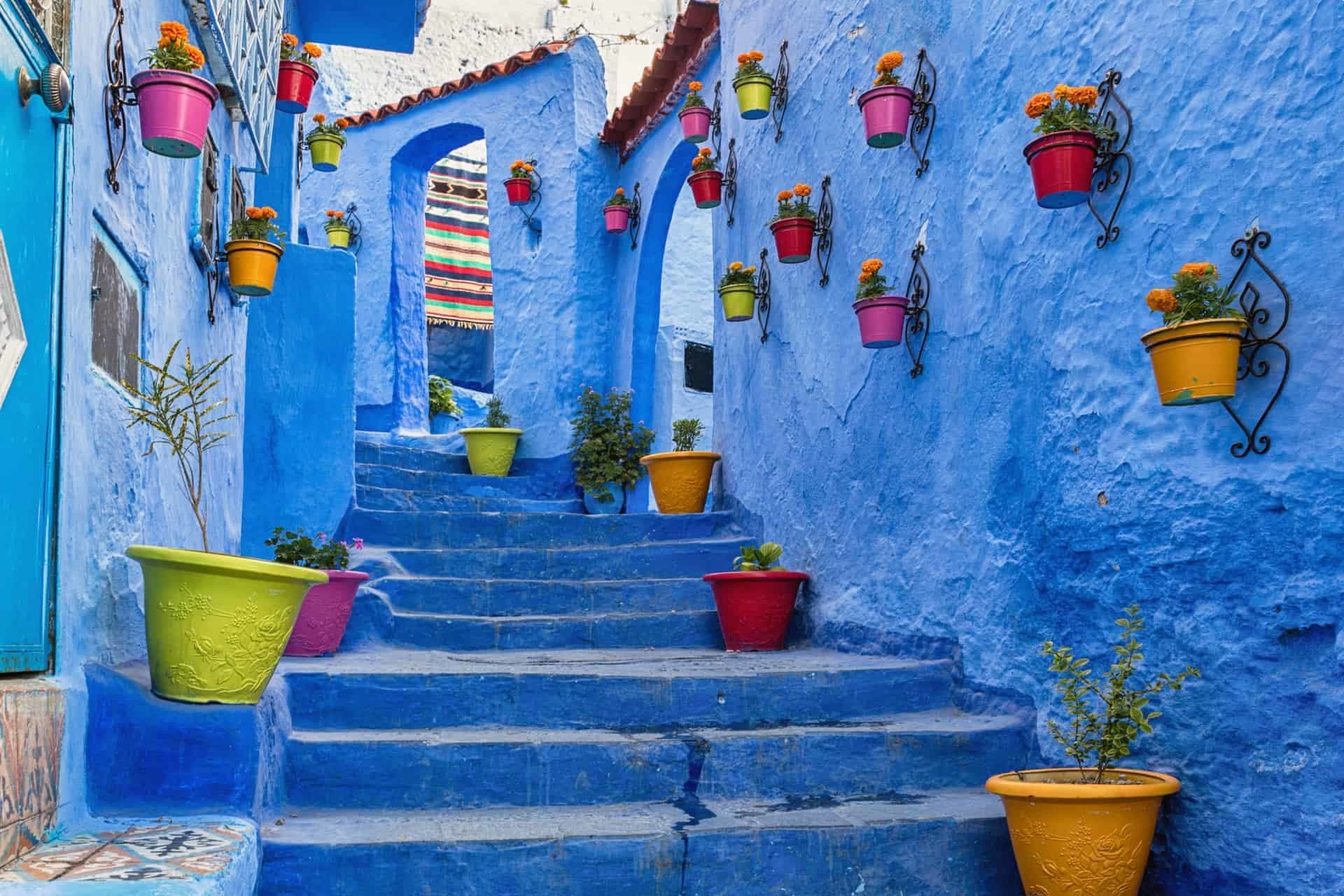
Ouarzazate – Ait Benhaddou
Ait Benhaddou is an ighrem (fortified village) in southern Morocco along the caravan route between the Sahara and Marrakech. It is a brilliant example of Moroccan earthen clay architecture, and is nicknamed ‘The Door of the Desert’. This beautifully preserved desert fortress has been popular a popular location for many Hollywood films and TV series, including Gladiator, The Mummy and Game of Thrones.
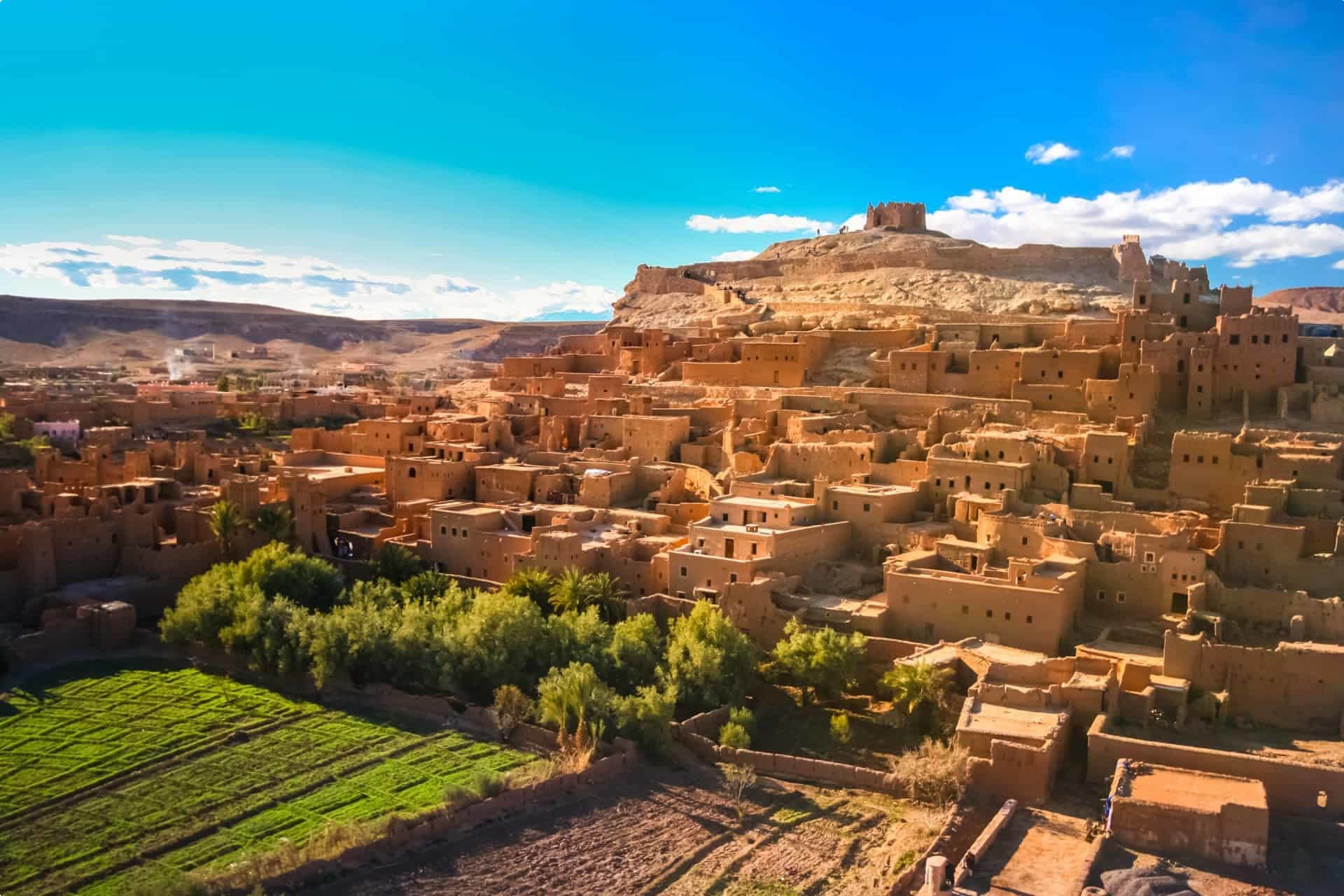
Erfoud – Merzouga – Erg Chebbi
Erfoud is a lively oasis town in the Sahara desert that is great for a pit stop on a tour of the desert regions of Morocco. The neighbouring town of Merzouga, close to Algerian border, has the largest natural underground body of water in Morocco. The region attracts a wide range of migratory and desert birds. The area has been identified as very similar in appearance to the surface of Mars, and as such is a popular site for space research.
But the truly unmissable attraction of the region is Erg Chebbi, a monumentally large red sea of wind-blown sand dunes. During the warmest part of the year, Moroccans travel to Erg Chebbi to be buried neck-deep in hot sand for a few minutes at a time, which is considered to be a treatment for rheumatism.
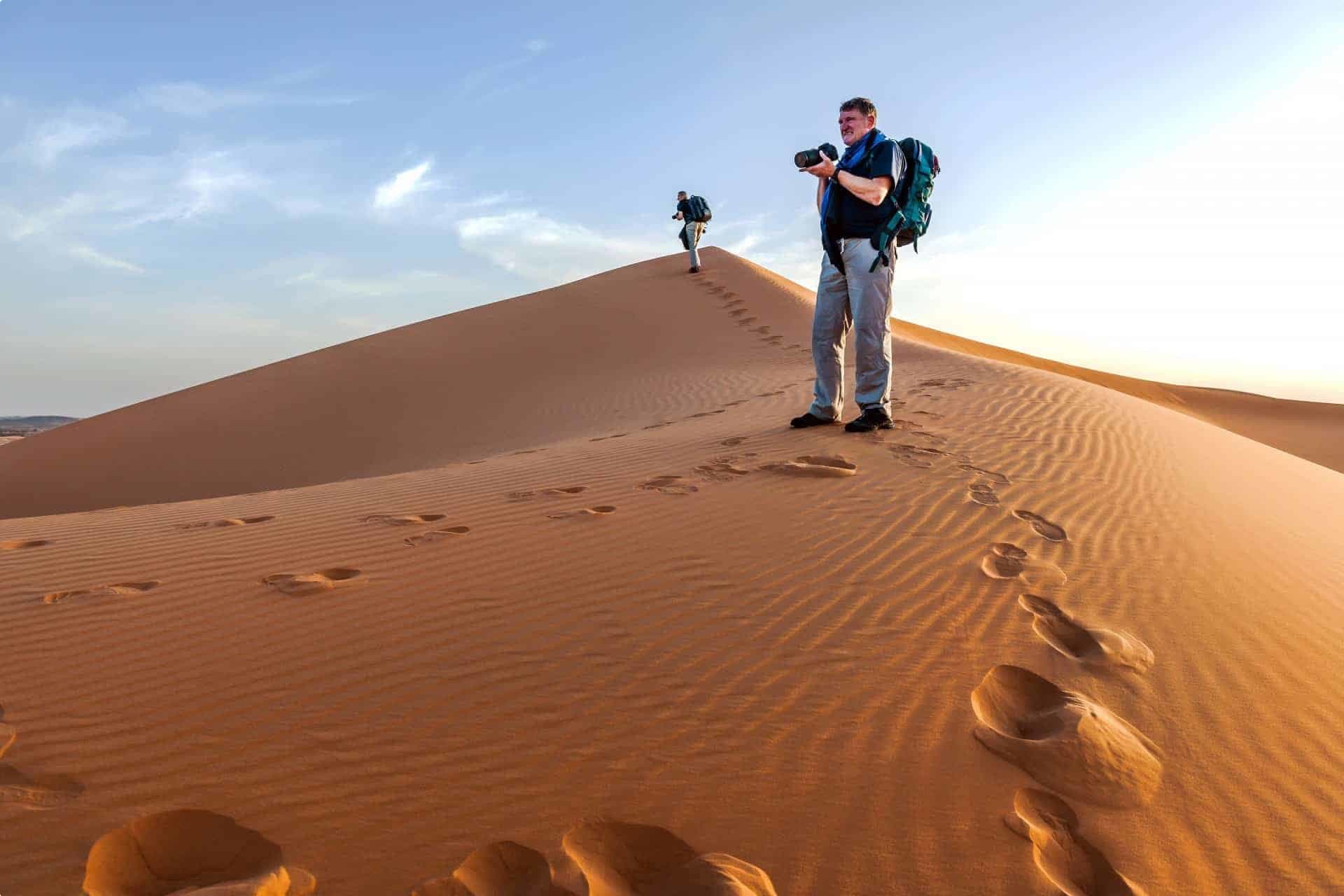
Odyssey Traveller’s small group tours
We provide worldwide experiences for mature travellers who are keen to blend a love of travel with a thirst for knowledge, and we welcome participants from any country.
Odyssey Traveller is famous for our small groups, and we average eight participants per tour. Our maximum group size is eighteen people, which ensures quality, flexibility and care that is tailored to our clients. We specialise in small group tours for the senior traveller who is seeking adventure or is curious about the world we live in. Typically, our clients begin travelling with us from their mid 50’s onward. But be prepared to meet fellow travellers in their 80s and beyond! Both couples and singles are welcome.
About Odyssey Traveller

Odyssey Traveller is committed to charitable activities that support the environment and cultural development of Australian and New Zealand communities. Accordingly, we are pleased to announce that since 2012, Odyssey has been awarding $10,000 Equity & Merit Cash Scholarships each year. We award scholarships on the basis of academic performance and demonstrated financial need. We award at least one scholarship per year. We’re supported through our educational travel programs, and your participation helps Odyssey achieve its goals.
For more information on Odyssey Traveller and our educational small group tours, visit our website. Alternatively, please call or send an email. We’d love to hear from you!
Related Tours
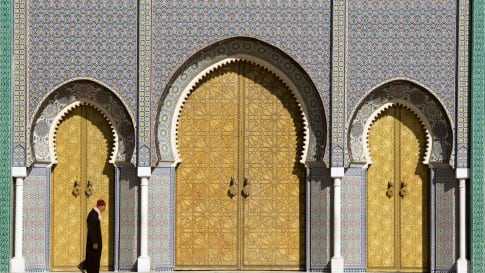
20 days
Apr, Oct, MarMorocco tour for senior travellers
Visiting Morocco
Embark on an unforgettable journey through Morocco: A Gateway to a world of vibrant colors, cultural diversity, and endless wonder. Join our escorted small group tour designed for senior travellers, whether you're a couple or a solo adventurer, and immerse yourself in the captivating allure of Casablanca, Fez, Meknes, Rabat, Marrakech and beyond. Experience the richness of Moroccan traditions and heritage as we explore this enchanting destination.
From A$11,915 AUD
View Tour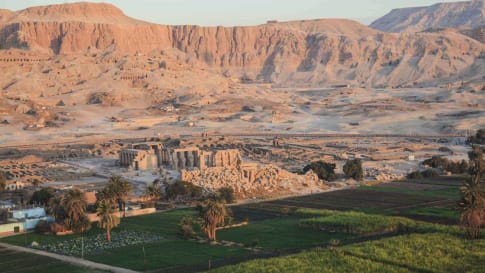
18 days
Nov, JanEgypt tour: escorted small group history & cultural tour of Egypt
Visiting Egypt
Our small group program for senior and mature couples and solo travelers takes us to contemporary feats such as the Aswan Dam and also to current crucibles of the Egyptian experience such as Tahrir Square. Proof, were it needed, that Egypt’s role as the pivot of civilisation is far from ended. There is the opportunity to visit our Morocco, Jordan or Iran tours before embarking on this tour of Egypt.
From A$12,950 AUD
View Tour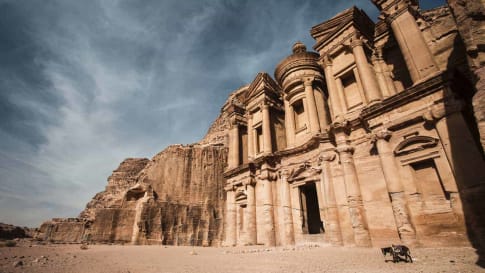
9 days
Jan, OctAncient History of Jordan | Escorted Small Group Tour
Visiting Jordan
Explore Jordan, visiting its capital city, Amman Jordan, the ancient Desert Castles, Petra and the Dead Sea on a small group package tour for mature and senior travellers travelling as a couple or Solo.
From A$6,750 AUD
View Tour
